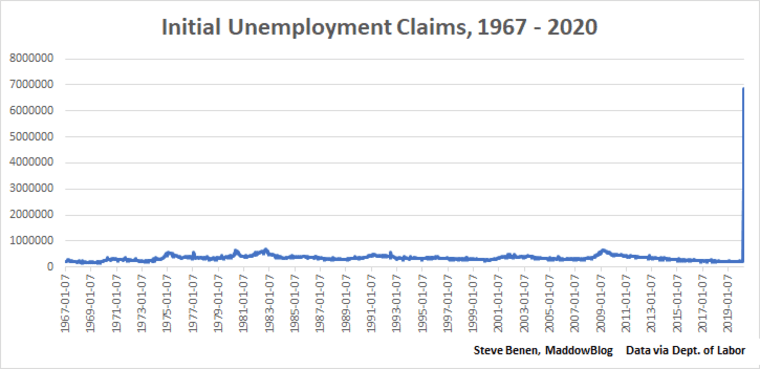
When Americans lose their jobs, they file for unemployment benefits, and the government has kept track of the number of these filings every week since 1967. Up until very recently, with a healthy domestic job market, the weekly tally has been about 210,000.
But as we've discussed, looking at historical data, we know what things look like when there's an economic crisis. In early 2009, for example, near the height of the Great Recession, initial jobless claims reached 665,000 -- roughly triple the totals from, say, a couple of months ago. During the U.S. recession in 1982, the number was a little higher, reaching nearly 700,000.
A few weeks ago, as the economy began to shut down in response to the coronavirus crisis, unemployment claims topped 3 million. As staggering -- and record-breaking -- as that number was, it was the first punch to the gut. The following week, that total more than doubled. This morning, the Department of Labor released yet another brutal report.
In the week ending April 4, the advance figure for seasonally adjusted initial claims was 6,606,000, a decrease of 261,000 from the previous week's revised level. The previous week's level was revised up by 219,000 from 6,648,000 to 6,867,000.
This new total is marginally better than last week's report, but it will be revised a week from now.
Note, these 6.6 million filings are separate from the last two similarly horrible reports. In other words, nearly 17 million Americans have filed initial unemployment claims over the last few weeks -- a total unlike anything the country has seen in modern times.
To be sure, we expected this report to be dreadful. The New York Times this morning pointed to projections as high as 6 million Americans joining the jobless rolls. But the actual number was considerably worse.
It is worth emphasizing that these depression-level numbers coincide with the recent passage of an economic aid package that included significant resources for the unemployed. As we recently reviewed, the provisions of the new law add $600 -- per week -- to whatever out-of-work Americans would get from their state UI system. It's a temporary lifeline that will make a significant difference to a lot of people.
I put together the above chart, and at the request of some readers, it shows weekly unemployment filings since 1967, when the federal government started keeping track. The image may make it appear as if the last half-century has been relatively stable, but that's really not the case: there were significant peaks and valleys throughout this period.
But those fluctuations now seem minor by comparison.

